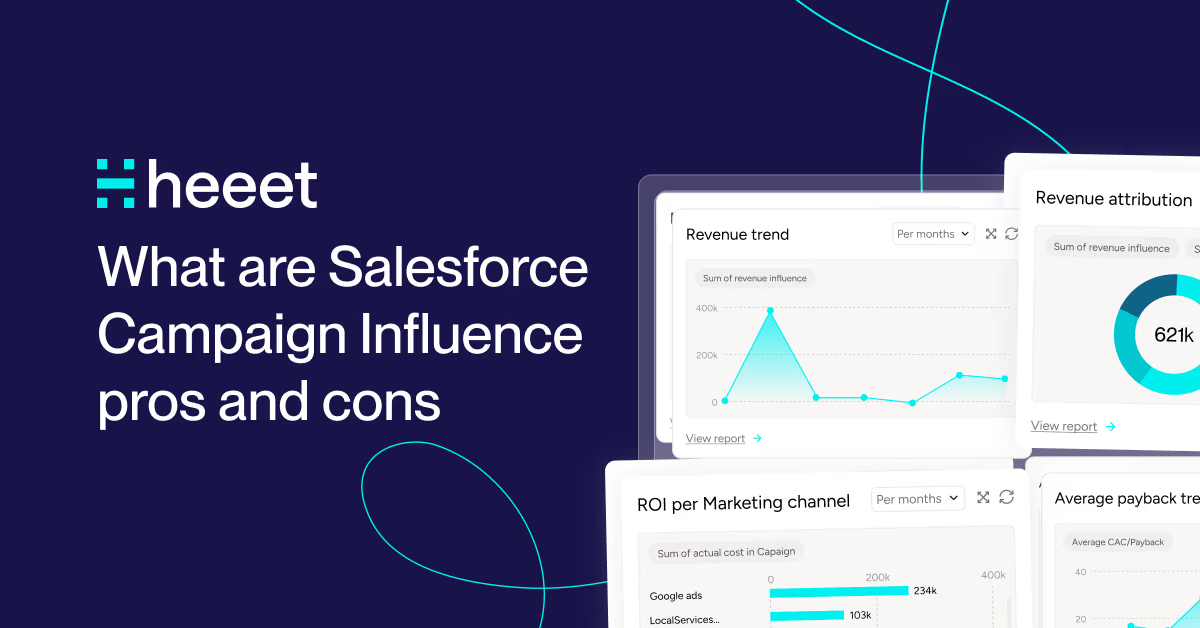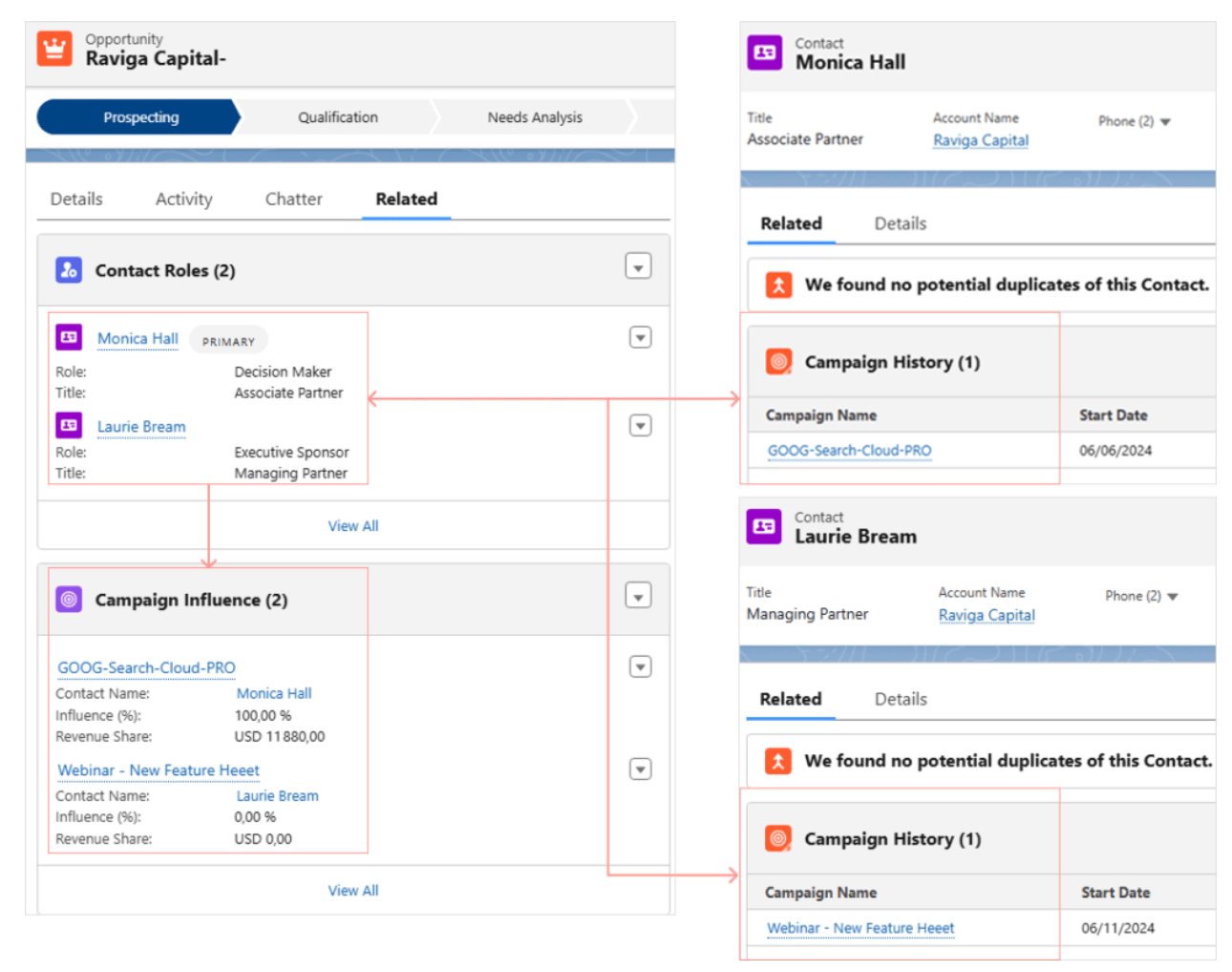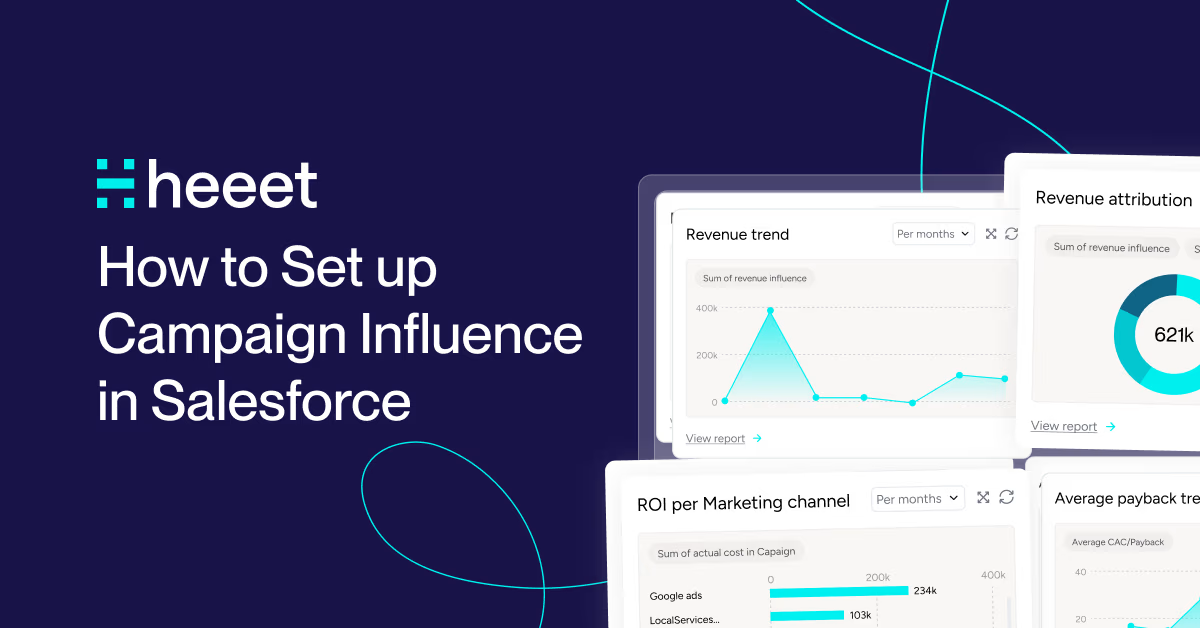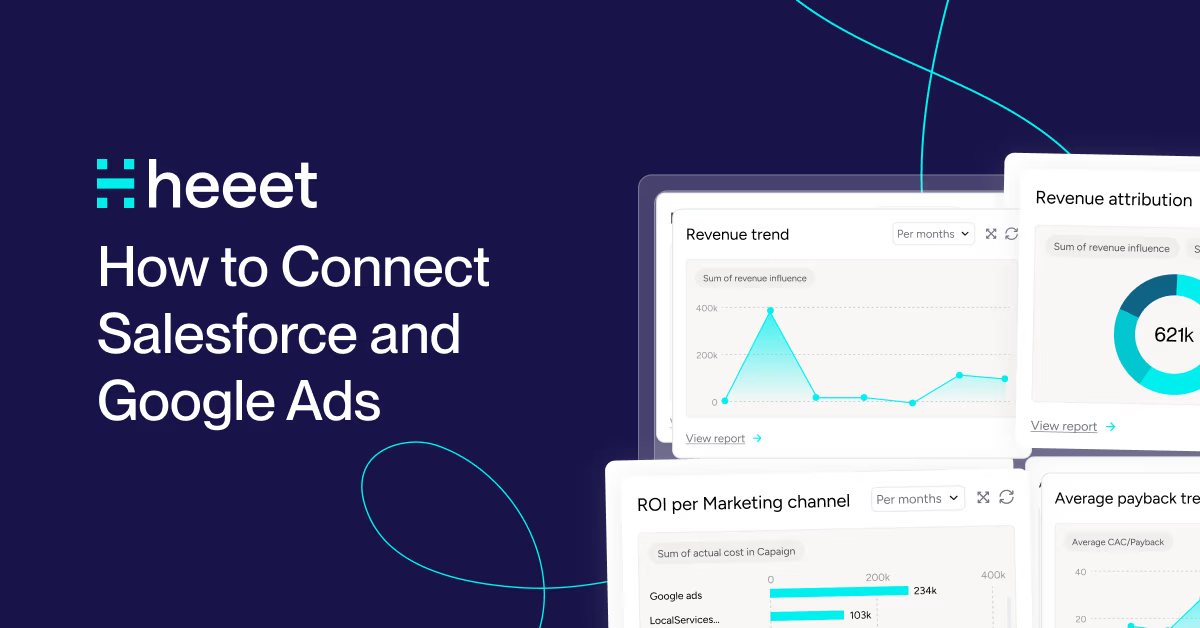Read time :
What are Salesforce Campaign Influence pros and cons
Discover Salesforce Campaign Influence pros & cons, and see how Heeet simplifies multi-touch attribution with real-time, cookieless tracking in Salesforce


Using Salesforce Campaign Influence offers several advantages and some potential downsides, depending on how it's implemented and the specific needs of your organization. Here's a breakdown of the advantages and downsides.
How does Salesforce Campaign Influence work?
Salesforce Campaign Influence is tightly related to Opportunity Contact Role and Campaign Member objects.
A Contact Role is a junction object between a contact and an opportunity while Campaign Member is a junction object between a Contact (or lead) and a Campaign.
For example let’s have the following use case for Pied Piper company.
1) Monica Hall was added as Campaign Member on Campaign A
2) Laurie Bream was added as Campaign Member on Campaign B
3) An opportunity is opened under Pied Pier account.
4) Monica Hall is added as Decision Maker and Laurie Bream as Executive Sponsor under Opportunity Contact Roles.
5) Automatically, Campaign A and Campaign B will be added as “Campaign Influence” on Acme Inc Opportunity.

Advantages of Using Salesforce Campaign Influence
1. Enhanced Visibility
Salesforce Campaign Influence provides enhanced visibility into the impact of marketing campaigns on lead and opportunity conversions. This helps marketing teams understand which campaigns are most effective at influencing conversions and making data-driven decisions.
2. Attribution Flexibility
You have the flexibility to create custom attribution models that align with your organization's unique sales process and customer journey. This allows you to assign credit to campaigns in a way that makes the most sense for your business.
3. Multi-Touch Attribution
Salesforce Campaign Influence supports multi-touch attribution, recognizing that leads often engage with multiple campaigns before converting. It provides a more accurate representation of the customer's journey.
4. Sales and Marketing Alignment
It fosters better alignment between sales and marketing teams by providing a shared view of campaign influence. Sales teams can see the impact of marketing efforts on opportunities, which can improve collaboration and communication.
5. ROI Analysis
You can conduct detailed ROI analysis for individual campaigns, helping you allocate your marketing budget more effectively and prioritize campaigns that deliver the highest return.
6. Customization
Salesforce allows you to customize Campaign Influence to meet your specific needs. You can create custom fields, reports, and dashboards to track and analyze campaign influence data as per your requirements.
Click here if you want to know more about Salesforce Campaign Influence reporting
Downsides and Considerations of Using Salesforce Campaign Influence
1. Manual maintenance of Campaign data
It still involves manual settings. Despite the Auto-association rules, this method still requires users to manually create Campaigns and link lead or contact records to them by using Campaign Member.
2. Manual maintenance of Contact Role data
You will need to ensure that your sales team is properly updating Contact Roles information on Opportunities, which can be quite an extensive work.
3. May require knowledge of flows
If you’re using multiple models, you’ll need to add additional criteria to your flow to loop through the various models. This is not straightforward and will require the attention of someone familiar with flows and the objects that need to be retrieved to make everything work.
4. Missing Channels
As the name suggests, Campaign Influence focuses on marketing campaigns. However, what about SEO, direct traffic, referrals, and affiliation? Without a proper tracking system, you’ll always end up with gaps in your data.
5. Limited Attribution Models
While you have the flexibility to create custom attribution models, this also means you need to define and maintain these models, which can be challenging if your business has evolving needs
In conclusion, Salesforce Campaign Influence can be a powerful tool for understanding and optimizing your marketing efforts, but it comes with certain complexities and considerations. It's essential to weigh the advantages against the potential downsides and determine if the benefits align with your organization's goals and resources. Proper planning, training, and ongoing management are key to successfully leveraging Campaign Influence for data-driven decision-making.
A Smarter Way to Do Attribution With Heeet
Heeet simplifies attribution by providing Salesforce users with accurate multi-touch tracking directly within their CRM. Unlike enterprise solutions that require months to implement, Heeet integrates seamlessly without BI tools or developers.
- Cookieless tracking technology ensures you maintain visibility regardless of browser settings or privacy changes.
- A tool designed for privacy. Your prospect data is not collected or processed outside your systems.
- Retrieve detailed data from Google Ads, LinkedIn, Meta, and more in just three clicks and get a comprehensive view of ad performance in Salesforce.
- Automatically track every interaction across your channels, including anonymous visits before a form fill, for full journey visibility.
- Update attribution models in real-time, allowing marketing teams to pivot strategies based on what worked today, not last quarter.
- Automate all attribution features, providing teams with accurate and complete CRM data to leverage.

Builds on attribution fundamentals while adding critical capabilities with Heeet:
- Track conversions and highlight the post-acquisition purchase journey, taking client interactions after they complete a form and speak with sales into account.
- Pre-built dashboards show users which channels, campaigns, and content pieces drive opportunities through each stage of your funnel to uncover hidden patterns.
- Get attribution transparency and understand precisely why each attribution decision was made
- Integrate Google Search Console with Salesforce to ensure that SEO efforts have a direct impact on revenue and understand how search performance impacts business outcomes.
- Identify exact phrases related to your keywords to help understand your prospects’ online searches.
- Provide Agentforce with the data to find the answers you’re looking for without digging through campaigns.
Heeet’s suite of features serves every team the intelligence to drive growth. Marketing and SEO teams can identify revenue-driving channels and content that generate revenue. Revenue operations optimize conversion processes. CEOs and CFOs get the revenue reports needed to maximize ROI through centralized spend data.
Implementation takes hours, with actionable insights delivered within the first week, enabling you to advance your campaign tracking to the next level.
Other articles
.svg)
Ready to track prospects from lead to close with Heeet?
Heeet gives marketers and sales professionals at IT & Security firms turn geuss work intro informed decisions that drive revenue while meeting the same secruity technical standards you provide your clients.








